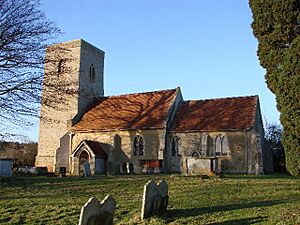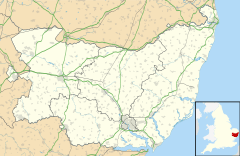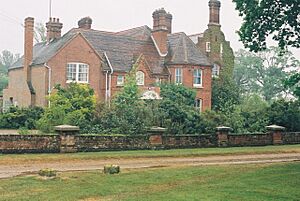Chillesford facts for kids
Quick facts for kids Chillesford |
|
|---|---|
 St Peter's Church |
|
| Population | 383 (Including Butley and Wantisden 2011) |
| Civil parish |
|
| District |
|
| Shire county | |
| Region | |
| Country | England |
| Sovereign state | United Kingdom |
| Post town | Woodbridge |
| Postcode district | IP12 |
| EU Parliament | East of England |
| UK Parliament |
|
Chillesford is a small village in the East Suffolk area of Suffolk, England. It is a quiet place located on the B1084 road. This road runs from east to west through the village.
Chillesford is about 3 miles northwest of the town of Orford. It is also 5 miles southwest of Aldeburgh and 6 miles south of Saxmundham. In 2011, the village's population was counted with the nearby area of Butley.
The village has a long history. It was first mentioned in the Domesday Book as Cesefortda. This was a very old survey of England from 1086. Later, in 1258, a person named Thomas Weyland bought the Manor of Chillesford.
Today, Chillesford has a pub called The Froize Inn. This building used to be two separate cottages. The village also has a church with a tall tower. Many buildings in Chillesford are made from special local red bricks called red crag bricks.
Long ago, a very large whale skeleton, about 20 meters long, was found near the old brickyard here. There are also old paths like Pedlars Lane, which goes north, and Mill Lane, which leads south towards Butley.
Contents
Chillesford Lodge Estate
Chillesford Lodge is a large estate located over a mile southeast of the village. It is near Sudbourne Park. In 2015, this estate was about 1,200 acres. It was the last part of the much larger Sudbourne Hall estate.
The Sudbourne Hall estate was bought in 1918 by Joseph Watson, 1st Baron Manton. His family still owns the Chillesford Lodge estate today. The buildings at Chillesford Lodge Farm were built in 1875. They were part of a "model farm" created by Sir Richard Wallace, 1st Baronet.
This farm was famous for developing the Red Poll breed of cattle. It also had a well-known group of Suffolk Punch heavy horses. These animals won many awards.
Chillesford Polo Ground History
Building a Unique Polo Field
In 1936, Alastair Watson, who lived at Chillesford Lodge, built the Chillesford Polo Ground. Polo is a sport played on horseback. This was a private club where teams played by invitation only.
The polo ground was special because it had an advanced watering system. This system used sprinklers to keep the grass healthy. It was unique in England at the time. Alastair Watson had seen similar systems in the United States. The equipment for the system came from Kentucky, USA. It was shipped on the first trip of the famous ship RMS Queen Mary.
The watering system was powered by an old engine from a 1917 Rolls-Royce Silver Ghost car. Alastair Watson bought this engine from a scrapyard.
Polo Matches and Closure
People were welcome to watch the polo matches for free. The club even provided printed programs with colorful covers. This was also new for a small polo club back then.
The club closed during World War II because the land was needed to grow food. It reopened in 1948. Sadly, in 1955, Alastair Watson had an accident during a polo match. He passed away some months later. After this, the polo ground was permanently closed and the land was used for farming.



